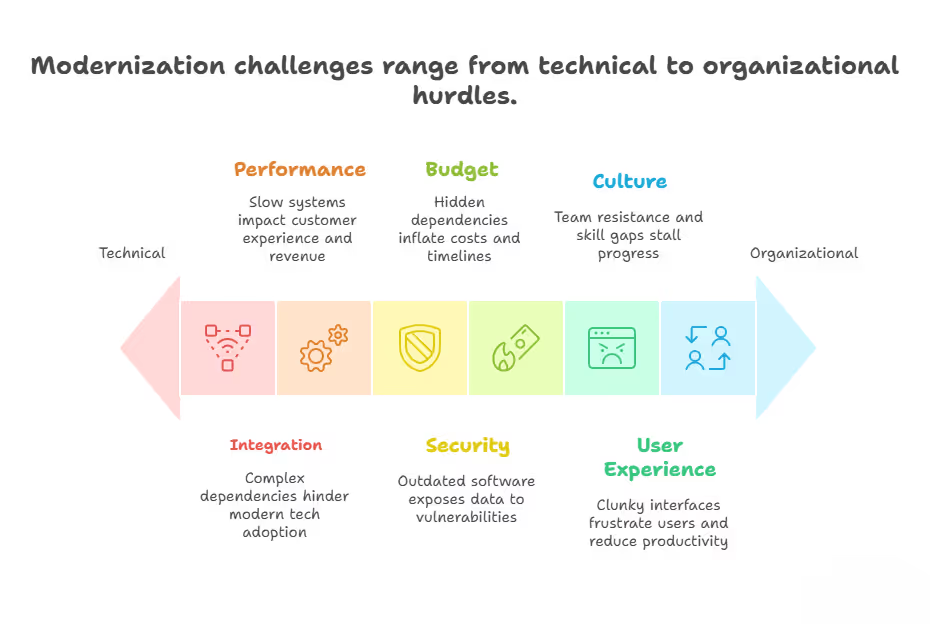Legacy UX Modernization: It’s About UX and Integration

Legacy UX Modernization Isn’t Just Code: It’s Users, Systems, and Culture
Legacy UX Modernization is the process of updating outdated digital interfaces and user experiences to meet current usability standards, design practices, and customer expectations, while often integrating with existing systems. It balances preserving core functionality with improving accessibility, performance, and visual design for modern users.

Why Is User Experience Such a Pain to Fix?
Legacy systems often have interfaces that feel like they belong in a museum, clunky, text-heavy, and slow. Users expect apps as smooth as their iPhones, and when they don’t get that, productivity and morale tank.
- Outdated Interfaces: Think green-screen terminals or endless menus. They frustrate employees who need fast, intuitive tools to do their jobs.
- Accessibility Gaps: Old systems rarely support screen readers or multilingual options, locking out users with disabilities and risking legal trouble.
- Change Resistance: Employees cling to familiar workflows, even if they’re inefficient. New UIs can spark pushback if not rolled out carefully.
- Speed Expectations: Users want apps to load instantly, but legacy systems struggle with today’s data demands, leading to delays and complaints.
I once helped a Minneapolis-based logistics firm overhaul their inventory system. The old UI was a nightmare, think 1980s DOS. We built a React-based front-end, kept key shortcuts to ease the transition, and trained users hands-on.
By the end, order processing was 35% faster, and the team actually liked the new system.
A 2024 Gartner study found 62% of U.S. employees lose up to 90 minutes daily on outdated UIs, costing millions in productivity.
What Makes Integration So Tricky?
Legacy systems are like tangled Christmas lights, pull one string, and the whole thing might break. Integrating them with modern tech is a minefield of complexity.
- Rigid Structures: Monolithic architectures don’t play nice with new features, making additions like real-time analytics a risky endeavor.
- Hidden Dependencies: Undocumented links in 20-year-old systems can derail projects, as teams discover them mid-upgrade.
- Data Migration Woes: Moving decades of data means dealing with weird formats and corruption risks, all while keeping everything intact.
- API Challenges: Legacy apps rarely have modern API endpoints, forcing teams to build complex workarounds that eat time and budget.
At a Denver manufacturer, their ERP couldn’t connect to modern supply chain tools. We used microservices to bridge the gap, enabling real-time tracking without gutting the core system.
It was a slog, but it saved them from a full rewrite.
A 2024 Deloitte study noted 68% of U.S. legacy systems struggle with extensibility, causing 50% of modernization projects to overrun budgets.
Why Do Teams Fight Modernization?
Your people are the heart of any system, but they can also be the biggest roadblock. Between retiring experts and nervous employees, the human side is tough.
- Knowledge Drain: Old-school coders who know your system inside out are retiring, leaving gaps that make maintenance a nightmare.
- Skills Shortage: Finding folks who understand COBOL or mainframes is like hunting for a unicorn in 2025.
- Fear of Change: Employees worry new tech means new training, or worse, job cuts, leading to pushback.
- New Skill Needs: Modern systems demand expertise in cloud, AI, or DevOps, which your team might not have.
At a Philadelphia bank, the team was dead-set against a new core system, fearing it would upend their routines.
We ran workshops showing how the tools simplified tasks, not replaced jobs.
Resistance faded, and 80% of staff were trained in weeks.
A 2023 McKinsey study predicts 42% of U.S. mainframe expertise will retire by 2030, risking project delays.
How Do Performance Issues Hit Your Bottom Line?
Slow systems aren’t just annoying, they cost you customers and cash. Legacy apps often can’t keep up with modern demands.
A Miami retailer’s e-commerce platform crashed during a 2023 holiday rush, turning customers away. We moved them to a cloud-native setup with Kubernetes, ensuring 99.9% uptime the next year.
Sales held strong, and the team breathed easier.
A 2024 Gartner report found 61% of U.S. legacy apps fail to scale, causing outages that impact revenue.
What Security Risks Come with Old Systems?
Legacy systems are a hacker’s playground, full of unpatched flaws and outdated tech that scream “attack me.”
- Vulnerabilities: Old software often has known bugs that hackers exploit, putting your data at risk.
- Compliance Woes: Meeting CCPA or HIPAA standards is nearly impossible with systems lacking modern security features.
- Modernization Risks: Upgrades can introduce new gaps, like misconfigured APIs, if you’re not careful.
- Audit Needs: Regular checks during modernization can catch issues before they become breaches.
A San Diego healthcare provider I worked with had an EHR system leaking patient data. We added encryption and zero-trust protocols during the upgrade, passing a 2024 HIPAA audit with no issues.
A 2024 Verizon report found 48% of U.S. breaches target legacy systems, highlighting the urgency of modernization.
Why Do Modernization Budgets Go Off the Rails?
Nobody likes a project that burns cash faster than expected, but legacy overhauls are notorious for it.
- Surprise Dependencies: Hidden links in old systems pop up mid-project, inflating costs and timelines.
- Scope Creep: Unexpected issues like compatibility problems stretch projects beyond their original plans.
- Long-Term ROI: Benefits take years to show, making it hard to sell to budget-conscious execs.
- Poor Planning: Skipping early assessments leads to costly surprises down the line.
A Seattle insurer’s 2022 project went 35% over budget due to undocumented dependencies.
For their next phase, we used dependency mapping tools and phased rollouts, staying within 3% of projections.
A 2024 PMI study found 72% of well-planned U.S. projects stay on budget, saving millions.
How Does Culture Make or Break Modernization?
Tech is only half the battle, your team’s mindset can sink or save your project.
A Los Angeles tech firm’s 2023 cloud migration stalled because IT and business units weren’t aligned.
We formed cross-functional squads, and they wrapped up 15% ahead of schedule.
A 2023 McKinsey study found 58% of U.S. modernization failures stem from siloed teams, underscoring the need for collaboration.
What’s the Smart Way to Modernize?
Here’s the playbook I’ve honed over years of getting these projects right.
- Deep Assessment: Map every dependency and user need before touching code to avoid surprises.
- Phased Rollouts: Incremental changes let you test and tweak without risking the whole system.
- User-First Design: Build flexible UIs with tools like Angular to keep users happy and productive.
- Train Early: Get your team on board with hands-on training and clear communication to cut resistance.
A Phoenix auto parts distributor modernized their ERP in 2024 with microservices and Angular. Early wins, like 25% faster order tracking, kept everyone motivated.
A 2024 Deloitte report found 64% of U.S. phased projects deliver ROI within 18 months, proving incremental wins work.
Your Next Move: Start Modernizing Now
Modernization isn’t just about tech, it’s about making your systems work for your users, your business, and your future. I’ve seen it transform companies, from faster operations to happier teams.
Start with a thorough assessment, roll out changes gradually, focus on intuitive UX, and train your people well.
For U.S. IT leaders, the path is clear: tackle modernization holistically, and you’ll turn your legacy headaches into a competitive edge.
Ready to dive in? Grab your team, map your systems, and let’s make it happen.

